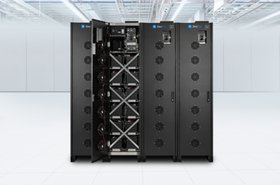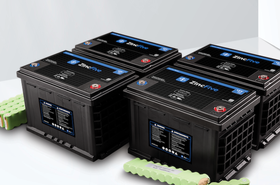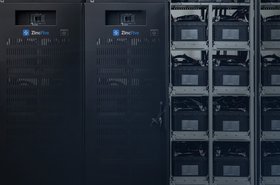The demands on data centers constantly change. On top of the ever-expanding need for data services, the very operations they’re supporting also evolve rapidly. In the US market alone, data center demand – measured by power consumption to reflect the number of servers a data center can house – is expected to reach 35 gigawatts (GW) by 2030.
That’s over twice the 17 GW demand in 2022. In just a few years, data centers currently addressing the needs of AI, cryptocurrency, and other cutting-edge technologies may be serving sectors that don’t even exist yet.
As companies adapt to a new era of digital transformation, data centers have also adapted to meet this increasing demand and unpredictability. Due to the constant improvements needed to adjust and expand data center capacity, new construction for data centers has rapidly shifted from traditional construction to prefabricated modular data center systems (PMDCs).
PMDCs are a design approach in which prefabricated units are assembled and outfitted with preselected, preconfigured equipment. This approach allows more flexibility in location and timing, and easier as-needed scaling and replacement of the center’s equipment and systems over time – perfect for the ever-shifting needs of data centers.
Organizations are already taking advantage of the cost savings, locational flexibility, and quicker construction periods of PMDCs. A recent survey of 228 data center executives found that over half had already deployed PMDCs, while 99 percent shared that they have plans to use modular data center designs in the coming years.
Modular data centers offer increased efficiency and flexibility
Modular data centers can be deployed in nearly any geographical location and avoid some of the more complicated aspects of traditional construction such as labor, transportation, and material constraints.
Modular designs also allow for elements to be added over time as needed, aligning realistically and in real-time with capital and operational resources. This helps the site avoid the costs of maintaining underutilized or completely unused equipment.
A modular power system’s preselected, preconfigured equipment includes components like switchgear, power distribution units, and uninterruptible power supplies (UPS). Operators can take the flexibility of PMDC design to ensure that the best equipment for their facilities are selected.
By selecting power system products that boast strong synergy with modular design, data center power systems can be smaller and more efficient, enabling a significant reduction in total cost of ownership (TCO).
For instance, nickel-zinc UPS batteries’ high-power density reduces the space needed for backup power supplies. Some nickel-zinc UPS battery cabinets can deliver as much power as lead-acid battery cabinets twice their size and weight.
This allows data centers to reduce cabinet count, which can make a major difference when modular power systems can average a cost of $10,000 per linear foot of container. The small footprint of these systems makes them ideal for incorporation into PMDCs.
Nickel-zinc UPS battery cabinets can also operate at higher temperatures than their counterparts. Modular designs pose an opportunity to create climate specific environments for the UPS and battery systems.
By utilizing nickel-zinc batteries, these rooms can operate at higher temperatures and offer the combined benefits of lower CapEx for lower capacity cooling systems, and reduced OpEx over the life of the cooling system.
As high temperature events increase in frequency due to climate change, investing in battery systems that can withstand harsher environments in 10-15 years is a distinct advantage for facilities being built today.
Battery safety can also be a strong contributor to lower TCO of modular power systems. Nickel-zinc batteries do not exhibit thermal runaway and don’t require the safety infrastructure needed with other volatile battery chemistries.
The infrastructure savings include lower capacity fire suppression systems, decreased structural burn rated materials, no deflagration venting, and more. Additionally, the safety enables lower cost shipping and transportation costs because the batteries do not need to ship separately and get re-installed at the final site.
PMDCs also offer improved sustainability
In addition to the benefits listed above, modular design also supports sustainable construction and operation of a data center. Increased demands for scope 3 emissions transparency are gaining momentum, driven by pressure from data center customers, investors, regulators and the general public.
Data centers who stay ahead of the competition in reporting and addressing emissions through scope 3 will attract customers and investors who are seeking comprehensive disclosure and commitments to sustainability. This not only applies to the sustainability of the data center companies themselves, but to the climate impact of the customers who utilize these data centers as part of their operations.
Alternative battery chemistries such as nickel-zinc have shown advantages across a myriad of sustainability metrics, and offer users a method of minimizing their supply chain impacts and overall container material due to a battery system footprint reduction compared to other chemistries. PMDCs offer a greater opportunity to implement and enjoy such sustainability benefits.
To fully maximize these benefits, selecting the equipment that best aligns with modular design will set operators apart from their competition, and showcase the readiness to adapt that has remained an essential key to success for the sector.
More from ZincFive
-

ZincFive announces new generation of its nickel-zinc battery cabinet
BC 2 is more compact than BC 1
-

Sponsored Four ways nickel-zinc batteries can save data centers money
The (financial) power of good chemistry with nickel-zinc batteries
-

Nickel-zinc batteries can reduce Scope 3 emissions
Battery chemistry can belp you report better and cut your footprint



